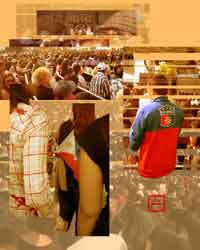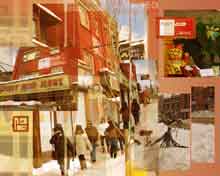Search for:
ARTISTIC CONTRIBUTIONS > Visual > Southeast
Asian
ROD DIOSO | Rod Dioso is an MA candidate in Digital
Arts at Camberwell College in London, England. His thesis documents
the visual representations of the Filipino community of London.
He is exploring the parallels between the fluidity of transnational
communities and the emerging new media of digital art.
He is a graduate of the Ontario
College of Art and Design (2000) and has exhibited in Toronto,
Montréal and Tokyo. He is a 2007 recipient of the Ontario
Arts Council Visual Artists: Emerging Grant. His work is part
of the City of Toronto Art Collection (2008). In 2006, he was
a spotlight artist for Toronto's MIX: a declaration of creative
independence. In 2003, he was shortlisted for the Aoyama Design
Award in Tokyo.
ARTIST STATEMENT | The Philippines has been exporting
labour on a mass scale since the 1980s, resulting in the forging
of migrant communities around the world. Yet these transnational
communities have been mainly quiet in their host countries, a
testament to the imbalance of power these immigrants feel and
evidence that remnants of
colonialism remain. Although Toronto is home to the largest Filipino
community in Canada (population of 150,000 according to Statistics
Canada 2001), the community's visual presence on the landscape
is scattered.
In the series of works submitted
to the Virtual Museum of Asian Canadian Heritage, I have attempted
to show the subtle imprints of Filipino-Canadians in Toronto,
highlighting aspects of Philippine culture that have been diffused,
morphed or have remained intact in the integration process of
the community to Toronto. In the creation of this body of work,
I have used images of Philippine storefronts, housing communities,
newspaper circulations, and advertising. My artistic process involved
the collection, appropriation, deconstruction and digital reconstruction
of these images and represents an exploration of the Philippine
diaspora.
Influences include artist Ken
Lum, who has explored themes of displaced identity in his Shopkeeper
Series (2000) where he has juxtaposed portraits of visual minorities
with commercialized slogans and signs. Similarly, I have appropriated
images of storefronts and local advertisements available in the
Toronto landscape.
Furthermore Manuel Ocampo's
use of transgressive Philippine iconography has highlighted for
me the need to make the invisible community more visible through
the use of symbolism. Where Ocampo used icons that referred to
latent post-colonial aggression, I have chosen imagery that highlights
the lived reality of neo-colonialism in the Philippine-Toronto
community as it stands on the periphery of popular Canadian culture.
Several of the works in this
collection (St. Jamestown I, II & III) were purchased by curator
Pamela Wachna and are part of the City of Toronto Art Collection
(http://www.toronto.ca/culture/fine_art.htm).
Special thanks to the Ontario
Arts Council for sponsoring this project.
 Making Waves (2008) Making Waves (2008)
C-Print
8" x 10" |
|
 Pinoy Mini Mart (2008) Pinoy Mini Mart (2008)
C-Print
10" x 8" |
|
 St. Jamestown I (2008) St. Jamestown I (2008)
C-Print
10" x 8" |
<<
top
 The project was made
possible with the support of the
The project was made
possible with the support of the
Department
of Canadian Heritage through the Canadian Culture Online Strategy
The Acrobat Reader is
available free from 